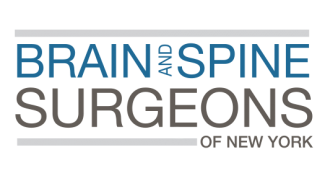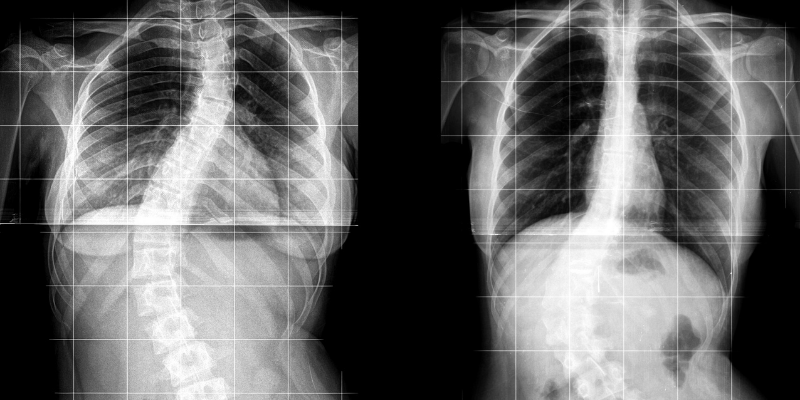
Case Study: Scoliosis Above Previous Fusion
The Problem
The patient is a 47-year-old-woman with a history of severe scoliosis. She was previously treated for back pain and difficulty walking with a lumbar fusion from L4-S1 in 2015 by Dr. Das. She was doing well after that initial surgery until early 2020 when she began developing severe back and left leg pain with difficulty walking. She came to see Dr. Das for evaluation and new imaging was ordered.
The Diagnosis
The patient’s exam, combined with the imaging, indicated a worsening of her existing scoliosis with severe coronal deformity and lumbar stenosis at L2-L3 and L3-L4. Due to the complexity of the case, Dr. Das consulted with his colleague, Dr. Krishn Sharma, an Orthopedic Spine Surgeon specializing in scoliosis, to determine the best treatment plan. Together they decided that by combining their individual expertise in both neurological and orthopedic surgery they would achieve the best outcome. Surgery was recommended and after risks, benefits, and alternatives were explained, surgery was scheduled.
The Treatment
In order to alleviate pain, straighten the spine, and improve ambulation, Drs. Das and Sharma worked as a team to perform a posterior fusion for correction of scoliosis from T4-S1. The surgery consisted of placing instrumentation from T4-S1, and a laminectomy of L2-L3 and L3-L4 with bilateral posterior osteotomies at L2-L3 and L3-L4. After first making a midline incision to identify the pre-existing hardware from L4-S1, the incision was extended all the way up to T4. The surgeons then removed the instrumentation from L4, L5, and S1 and found a solid fusion between L4 and S1.
Using computer navigated image guidance to aid in spatial positioning and orientation of surgical tools, Drs. Das and Sharma placed the pedicle screws on both the left and right sides from T4-L3. Once EMG stimulation was done and all screws gave satisfactory readings, they removed all of the L3 lamina and the bottom of L2. They performed the facetectomies bilaterally and loosened up the facet to allow mobilization of the spine. A rod was then placed into the screw heads and they derotated the spine to correct the deformity as much as possible with significant improvement also seen in the coronal alignment. Once this was done, the screws were locked in place and a final tightening was performed.
Drs. Das and Sharma then turned to the fusion and decorticated the lamina and facet joints from T4-S1, placed an allograft (a tissue graft from a donor) posterolaterally with the local bone from the laminectomy. Allograft was also placed over the lamina in the thoracic spine, over the transverse processes in the lumbar spine at the level of the decompression, as well as over the fusion mass. After five days in the hospital, she was stable for discharge to a rehab facility where she completed her recovery.
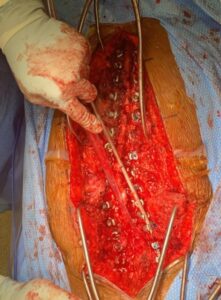
Identifying old hardware & placing screws during the operation.
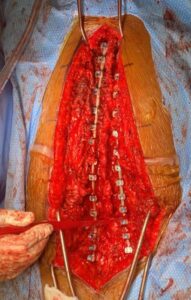
New hardware in place & straightening of the spine before bone graft.
The Outcome
After living with increasing pain and progressively worsening ambulation for more than a year, eight weeks after surgery the patient is doing extremely well and feels she has her life back.
She is now home after spending three weeks in an acute rehab facility, her incision has completely healed, she is standing up straight and ambulating with minimal assistance. Postoperative X-rays demonstrate no complications with the hardware and excellent correction of her previous scoliosis with marked improvement of her condition.
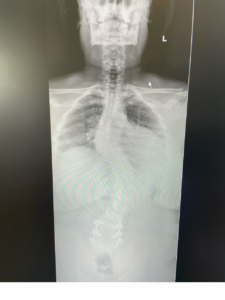
Scoliosis with severe coronal deformity and lumbar stenosis at L3-L4 and L2-L3
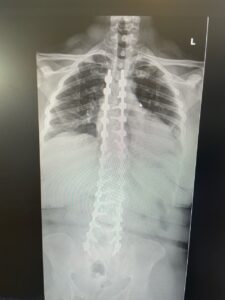
Postoperative X-rays show excellent correction of her previous scoliosis with marked improvement.
Meet the Surgeons
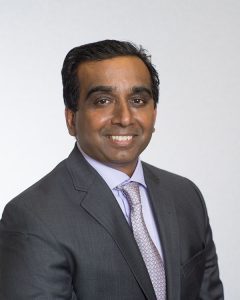
Dr. Kaushik Das is a neurosurgeon specializing in spine disorders. Dr. Das has been alleviating patient fears for more than a quarter of a century. He went into neurosurgery because he wanted to make an impact. Dr. Das began his journey in 1989 at the State University of New York at Stony Brook where he completed his undergraduate degree in biochemistry. He went on to attend medical school at the State University of New York in Brooklyn (Downstate) where he graduated cum laude in 1993 and was a member of AOA honor society. He completed his Neurosurgery residency in 1999 from NY Medical College/ Westchester Medical Center in Valhalla NY and then went on to complete a Spine Fellowship at the Barrow Neurologic Institute in Phoenix, AZ in July 2000. He currently is a Clinical Associate Professor of Neurosurgery at NY Medical College. Click here to learn more about Dr. Das.
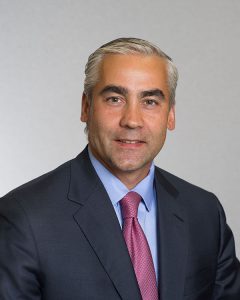
Dr. Krishn M. Sharma was in practice in New York and Connecticut for over a decade before joining BSSNY. Dr. Sharma received his medical degree from New York Medical College and was a member of AOA honor society. He completed an Orthopaedic Surgery residency at Union Memorial Hospital, The Johns Hopkins Hospital, and Shock Trauma Center at the University of Maryland in Baltimore, MD. He also completed a scoliosis and spinal surgery fellowship at the Spine Institute of New York with Dr. Michael Neuwirth. He is an expert in spinal deformity and complex reconstructive spine surgery for children, teens, and adults. He has broad experience in degenerative conditions including herniated discs and spinal stenosis and employs minimally invasive techniques where applicable. Click here to learn more about Dr. Sharma.

